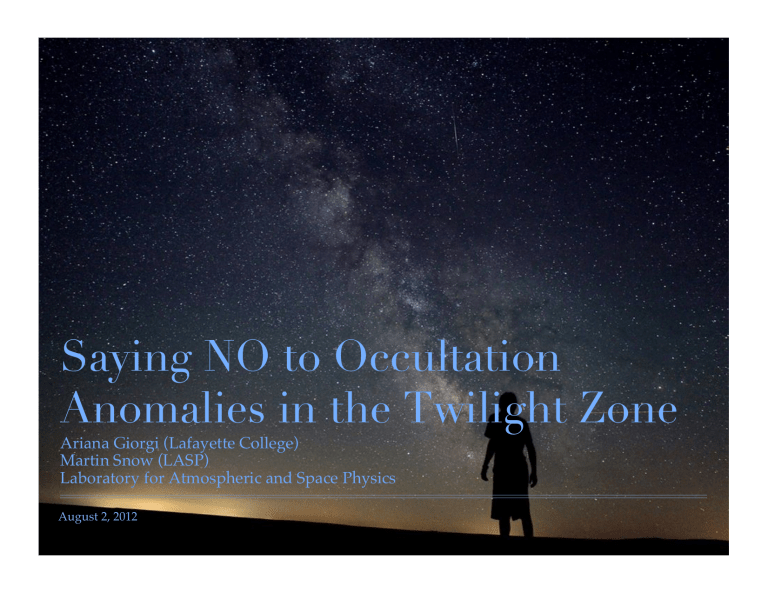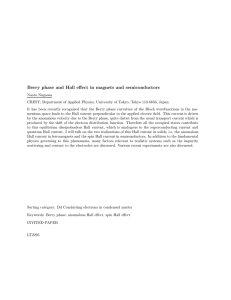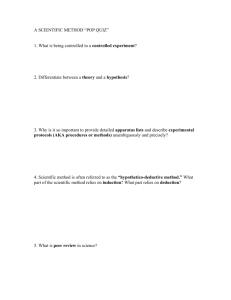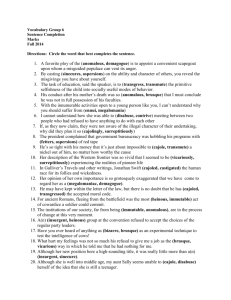Document 12625106
advertisement

Saying NO to Occultation Anomalies in the Twilight Zone Ariana Giorgi (Lafayette College) Martin Snow (LASP) Laboratory for Atmospheric and Space Physics August 2, 2012 SORCE AND SOLSTICE ✤ ✤ SOlar Radiation and Climate Experiment (SORCE) ✤ Launch January 25, 2003 ✤ Carries four instruments: SIM, SOLSTICE, TIM, and XPS SORCE SOLar STellar Irradiance Comparison Experiment (SOLSTICE) ✤ ✤ Stellar occultation measurements in the ultraviolet at 250nm Compares daily solar UV irradiance measurements to irradiance from 18 stable early-type stars Stellar Occultation ✤ Geometry ✤ Measure irradiance as the star sets behind the Earth Star Orbital Motion Sun Normal Observation ✤ Counts: can be used to determine transmission ✤ ✤ ✤ where I=irradiance Can invert the transmission to get density Purpose of these experiments is to measure ozone density I0 Anomalous Observation ✤ ✤ Anomalous observations in the data that did not fit in with the majority Filtered the observations ✤ ✤ Fit a line to the points above 150 km If slope < -1, then I considered it anomalous KEY Red: Anomalous Emission Black: Normal Emission Anomalous Observations Emission # : Date Local Time Hemisphere Tangent Pt Height (km) Star Name 1 Nov 21, 2004 0:21 S 124.197 sig_sgr 2 Nov 25, 2004 23:25 S 107.266 sig_sgr 3 Nov 27, 2004 22:47 S 94.083 sig_sgr 4 Dec 25, 2004 0:10 N 166.463 alf_lyr 5 Dec 29, 2004 22:40 N 112.836 alf_lyr 6 Jun 23, 2005 2:09 S 90.642 alf_vir 7 Aug 24, 2005 1:42 S 74.013 dlt_sco 8 Nov 20, 2005 1:32 N 144.063 alf_lyr SOLSTICE Instrument ✤ Measures middle and far ultraviolet ✤ MUV: 180-300nm ✤ FUV: 115-180nm SOLSTICE SOLSTICE Layout ✤ ✤ ✤ Light hits one of two detectors Mirror changes position to switch between detectors Both detectors read data at the same time ✤ Light hits one, while the other is subjected to environment Wavelength Distribution ✤ As wavelength changes, amount of signal decreases ✤ ✤ Wavelength doesn’t occupy as much of the aperture For low resolution spectrum, any wavelength in range will be detected KEY This graph shows what % of wavelength deviation will be received SOLSTICE Instrument ✤ ✤ Thought one explanation for anomalous observations may be background environment ✤ Areas of radiation Inspected inactive channel ✤ Looking for counts over 20/30 ✤ Found nothing concerning - rule out inactive channel For this inactive channel, the dark rate is about 3, normal statistical variance SOLSTICE Instrument ✤ ✤ The occultations are scheduled to occur during the nighttime of the orbit From geometry, if line-of-sight is out of sunlit part of atmosphere then there is nothing to scatter the sunlight ✤ ✤ Star Rule out observations that clearly lie in the sunlight since this may be the case Some anomalous observations are close to terminator while others are not Orbital Motion Sun Map of Anomalous Occultations Northern Winter (November/December) KEY Red: Satellite Location Yellow: Tangent Point Location Green: Location where line-of-sight reaches edge of atmosphere Map of Anomalous Occultations Northern Summer (June/August) KEY Red: Satellite Location Yellow: Tangent Point Location Green: Location where line-of-sight reaches edge of atmosphere Modeling the Emission ✤ ✤ Fit a Gaussian curve to the modeling in order to determine characteristics of the layer producing the emission To improve fit, I accounted for ozone absorption ✤ ~ 60-90 km Accounting for Ozone ✤ Fit an exponential line to the star observation data ✤ Checked to see if transformation was appropriate ✤ ✤ Goal was to adjust the stellar signal to account for loss of transmission from ozone between ~ 60 and 100 km ✤ ✤ Look at the adjustment for the star observation Make a more symmetrical curve for a better Gaussian curve Averaged the best-fit line of each star to create one line Accounting for Ozone KEY Black: Star Observation Red: Anomalous Observation Blue: Correction for Ozone Absorption Locations of Observations Locations of Anomalous Observations Atmospheric Cause ✤ Likely emission source could be nitric oxide (NO) ✤ Background reading on NO and NO densities (Barth, et al) ✤ Equatorial Region ✤ ✤ ✤ ✤ Solar soft x-rays in lower thermosphere btw 100-150 km There is an increase around ~120km during geomagnetic storms Auroral Region ✤ Auroral electrons precipitate into thermosphere ✤ Correlate with magnetospheric activity Maximum density of NO is btw 60-70 deg Nitric Oxide Wavelength (Bertaux, et al) KEY This graph shows what % of wavelength deviation will be received Atmospheric Cause ✤ ✤ NO emission has been seen during the night on Spectroscopy for Investigation of Characteristics of Atmosphere of Mars (SPICAM) via stellar occultations (Bertaux, et al) Suggests NO can emit ultraviolet in nightside from chemiluminescence ✤ ✤ Mars Express Chemiluminescence: emission from light resulting from chemical reactions ✤ O & N atoms in dayside thermosphere are transported to nightside ✤ Descend vertically and produce gamma, delta bands of NO This motion is expected in winter polar mesosphere Geomagnetic Activity ✤ ✤ Thought to try and correlate these anomalous observations with geomagnetic activity Compared against 5 different indices ✤ ✤ ✤ DST, Kp, AE, IMF, Solar proton events Solar proton events (proton storms): Dates of proton storms did not correlate with observations Compared anomalous observations against normal occultations of similar latitude to try to identify a difference DST (Disturbance Storm Time) KEY Red: Anomalous Observation Blue: Star Observation at similar latitude Kp; Planetary K (Measures Geomagnetic Storms) KEY Red: Anomalous Observation Blue: Star Observation at similar latitude Auroral Electrojet (Auroral Zone Magnetic Activity) KEY Red: Anomalous Observation Blue: Star Observation at similar latitude IMF (Interplanetary Magnetic Field) KEY Red: Anomalous Observation Blue: Star Observation at similar latitude Conclusions/Future Research ✤ High possibility that observations are a result of chemiluminescent NO emissions from O & N ✤ ✤ Further research should be done with data to determine ways to confirm Though no strong correlation with indices, cluster that occurs predominately during Nov/Dec Emission # : ✤ Further inspection between seasonal events Date 1 Nov 21, 2004 2 Nov 25, 2004 3 Nov 27, 2004 4 Dec 25, 2004 5 Dec 29, 2004 6 Jun 23, 2005 7 Aug 24, 2005 8 Nov 20, 2005 Acknowledgments ✤ LASP REU Program ✤ ✤ Marty Snow, Erin Wood SORCE References ✤ ✤ Barth, C. A, et al. "Global Observations of Nitric Oxide in the Thermosphere." Journal of Geophysical Research 108.A1 (2003): n. pag. Print. Bertaux, Jean-Loup, et al. "SPICAM on Mars Express: Observing Modes and Overview of UV Spectrometer Data and Scientific Results." Journal of Geophysical ResearchS90 111.E10 (2006): 18-22. Print.



